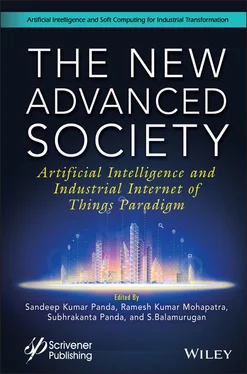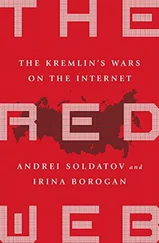A 360-degree view of the different dimensions of this revolution is presented in this book, including the various industries transforming industrial manufacturing, the security and challenges ahead and the far-reaching implications for society and the economy. The main objective of this edited book is to cover the impact that the new advanced society has on several platforms such as smart manufacturing systems, where artificial intelligence can be integrated with existing systems to make them smart, new business models and strategies, where anything and everything is possible through the internet and cloud, smart food chain systems, where food products can be delivered to any corner of the world at any time and in any situation, smart transport systems in which robots and self-driven cars are taking the lead, advances in security systems to assure people of their privacy and safety, and smart healthcare systems, where biochips can be incorporated into the human body to predict deadly diseases at early stages. Finally, it can be understood that the social reformation of Society 5.0 will lead to a society where every person leads an active and healthy life.
Included in this book are the fundamentals of Society 5.0, artificial intelligence, and the industrial internet of things, featuring their working principles and application in different sectors. In order to meet these objectives, accomplished writers in the field have contributed the 19 chapters summarized below.
– Chapter 1discusses areas of management, cybercrime in the financial sector, human depression, and school/college closures. Moreover, the constraints posed by returning migrant workers and the remedial measures devised to overcome them, and how to build a new advanced society in a post-COVID-19 era are also discussed.
– Chapter 2elaborates on the clients, architects, contractors, material suppliers, etc., in the construction industry. The complex supply chain of globally manufactured construction products has to be managed for the sake of meeting quality requirements and customer satisfaction. But, the lack of accountability in the construction industry sometimes leads to various types of errors, delays, and even accidents at some stages. This chapter introduces the key to ending these disputes with the help of Corda, a distributed ledger platform for permissioned networks inspired by blockchain technology. This helps in maintaining transparency among the actors involved in this industry, thus avoiding any miscommunication.
– Chapter 3analyzes the identity and access management challenges in the IoT, followed by a proposal of a cloud identity management model for the IoT using distributed ledger technology.
– Chapter 4elucidates the development of an efficient deep neural network (DNN) with a reduced number of parameters to make it real-time implementable. The architecture was implemented on German traffic sign recognition benchmark (GTSRB) dataset. Four variations of neural network architectures—feedforward neural network (FFNN), radial basis function neural network (RBNN), convolutional neural network (CNN), and recurrent neural network (RNN)—are designed. The various hyperparameters of the architectures—batch size, number of epochs, momentum, initial learning rate—are tuned to achieve the best results.
– Chapter 5deals with the basic aspects of honeypots, their importance in modern networks, types of honeypots, their level of interaction, and their advantages and disadvantages. Furthermore, this chapter also discusses how honeypots enhance the security architecture of a network.
– Chapter 6provides an in depth review of the necessity for security in IoT platforms and applications of the industrial internet of things (IIoT). Over the past decade, cyberattacks have mostly occurred on IoT devices; therefore, cybersecurity is introduced to deal with these cyberattacks. Furthermore, one of the chief attack modes in the IIoT are botnets and denial-of-service attacks. These attacks happen in several ways, and once they have occurred it is hard to predict and stop them. This chapter highlights many suggestions from diverse authors, which are detailed in tabular form.
– Chapter 7proposes an efficient navigation controller embedding hybrid Jaya-DE algorithm to obtain the optimum path of an individual robot. The efficiency of the proposed navigation controller was evaluated through simulation. The outcomes of the simulation revealed the efficacy of the suggested controller in monitoring the robots towards achieving a safe and optimal path. The strength of the suggested controller was further verified with a similar problem framework. The potency of the proposed controller can be seen from the outcome in resolving the navigation of mobile robots as compared to its competitor.
– Chapter 8discusses a study conducted for diagnosing Parkinson’s disease using different machine learning (ML) algorithms for categorization and severity prediction through the measure of 16 voice and eight kinematic features accomplished with various archives. The dataset included 40 people with Parkinson’s disease and healthy patients generated with the help of spiral drawings and voice readings. Of the various ML algorithms used for estimating, the highest accuracy (94.87%) was demonstrated by ANN, while Naïve Bayes was the least precise (71.79%). The work also predicted a severity score by suggesting some scientific measures with a prototype dataset.
– Chapter 9discusses the challenges faced in the development of a multi-sensor classification system and their possible solutions. Smart agriculture in rural areas can largely benefit from the low-power, low-cost sensors and aerial devices to sense (soil, temperature, salinity, water, light, insects, pests) and exchange data/images for monitoring and controlling crops.
– Chapter 10builds a classification model that classifies whether a customer is going to buy a car with specific features. This research work consisted of four ML models and an analysis of their results. These classifying models were Gaussian Naïve Bayes, decision tree, Karnough Nearest Neighbors and neural networks. The author also attempted to find the best hyperparameter value to obtain the best result from these models. These results are used to compare the accuracies of every model and decide the best model for use in real-time prediction. Here, the author was predicting whether a customer was going to buy a car or not buy a car with particular features available in it. Hence, for this prediction the best accuracy we got was 97.4%, which was given by the decision tree classifier. Also, the neural network had about the same prediction accuracy. Therefore, this ML model can be used by a firm to determine whether or not a new car with specific features will sell well or by a customer wanting to know whether a particular car will be bought by other customers as well.
– Chapter 11examines the use of AI and ML in political campaigns. It is divided into three sections—the first section explores internet penetration and the influence of social media on the Indian Lok Sabha election; the second section explores the forms of deepfake and automated social media bots and their use during the election campaign; and the final section explores the future of AI and ML in the election campaign in India.
– Chapter 12attempts to explain the impact of segment routing (SR) in software-defined networking (SDN). For this, the authors implemented three algorithms known as multi-objective particle swarm optimization (MOPSO), advanced MOPSO (A-MOSPO) and minimum interference routing algorithm (MIRA) on a Waxman network topology created randomly having 100 nodes. For performance evaluation, MATLAB and parameters such as throughput, link utilization, and delay were taken as the key parameters for evaluating the above protocols in an SDN environment.
Читать дальше












